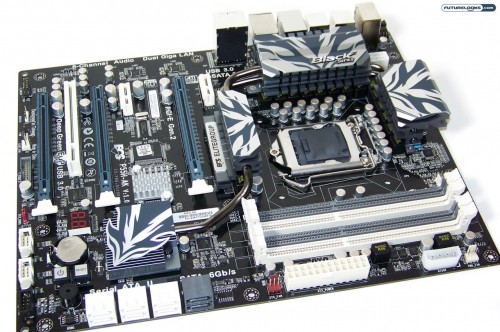
One of the things that arguably penalizes the current P55A/H55 budget and mainstream motherboards is the sharing of the system bus that connects the PCI Express, USB 3.0, and SATA3 devices. So basically, the more video cards and devices you add to the bus the more each devices’ transfer rates take a performance hit. But, not too many folks realistically run dual graphics on those platforms nor often run both USB 3.0 and SATA3 devices simultaneously. However, some folks really are power users and really do need a solution like the ECS EliteGroup P55H-AK Motherboard to help open up all those lanes for unhindered performance. Let me show what we mean.
Features and Specifications
What frees up the ECS P55H-AK allowing it to offer full speed PCI Express performance is the integration of the NVidia NF200 controller. That’s how the board is able to offer Triple SLI support. That means full speed x16 from PCIE slot 1 with one card, and when in Triple SLI, x8 speed from slot 2 and 3. This is basically typical performance when using the controller.
Next, ECS chose to implement an extra PLX PEX 8608 PCIe Gen 2 switch (chip) to help accelerate DMI performance by adding an extra 4 PCIE lanes. This is what keeps the dual NEC USB 3.0 and Marvell SATA3 controllers moving smoothly without sharing any of the system bus. Further simplified, this allows the devices to perform as fast as they can at all times. It also adds extra USB 3.0 and eSATA3 ports for users with more ambitious storage needs.

Looking at the big list of features, ECS aimed at making the P55H-AK user friendly. Features like eBLU (a live BIOS update utility) and eDLU (a live drivers update utility) always come in handy when first setting up. Also, EOC (Easy Over Clock Utility) is their latest Windows based overclocking program designed just for overclocking along with profiles and plenty of adjustable options for the novice. For experience overclockers, the M.I.B.X. (Ultimate BIOS OC) interface offers all the options you need including the ability to save your overclocking profiles.
The full speed triple graphics and PCIe support is what separates this board from other price point boards. Feature for feature, this board seems to compete well with other similarly priced products. The $299 US price tag for the P55H-AK seems justified given all that is packed in.
Unboxing and Handling the ECS P55H-AK Motherboard
A few of the things you’ll notice is the sharp looking heat sink and color theme. Let’s take you in closer and give you a good look at what you’re getting. Check out the video below:
Like I said, it’s not your common ECS high board. This new board takes a step forward in to the higher end sector. Let’s see if its performance is higher end.
Test System and Installation Notes
This platform appears to be tuned for full performance at all times. And, given its price and features, it should be able to do a bit of overclocking. I assembled the entire test system based on these factors to see if it measures up to ECS’ new found push for producing performance motherboards. Here is the break down:
- Processor: Intel Core i5-661 Clarkdale
- Motherboard 1: ECS P55H-AK (BIOS 08/04/2010)
- Motherboard 2: GIGABYTE GA-P55A-UD6 (BIOS F11)
- Memory: Patriot ViperII Sector5 4GB 2400MHz DDR3 @ 1333MHz (8-8-8-24)
- Graphics: ZOTAC Geforce GTX 280 1GB
- Storage: OS Drive – Kingston 128GB V+ SSDNow
- USB 3.0 Device: Rosewill R358-UB3 w/Western Digital 2TB Black HDD
- SATA3 Device: Seagate Barracuda 2TB HDD
- Power Supply: Antec Quattro TPQ-1200
- Operating System: Windows 7 Pro 64-bit
- CPU Cooler: Thermalright MUX-120
Naturally, this is a freshly patched OS installation. I’m also using the latest BIOS, chipset, audio driver, and video card software for each build. This includes each platform’s latest versions of overclocking software. If this platform can overclock, we want to know about it.
About the only operational notes worth mentioning is that there is a momentary pause before anything happens after pressing the on board power button. After flashing the BIOS, the LED function has to be turned back on so you can see it. Also, the CMOS CLR (BIOS reset) button sometimes needs held in the clearing position for a few seconds or else it doesn’t actually reset the BIOS. Not exactly major, just more of an unknown annoyance.
